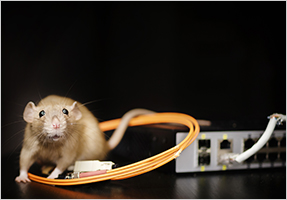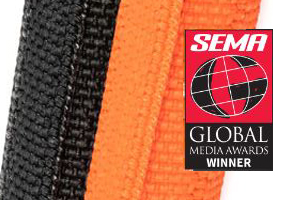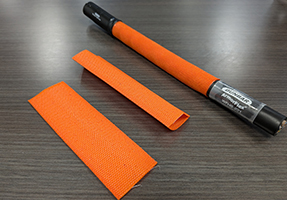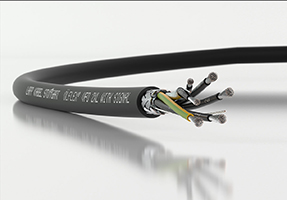Cable Sleeving Beyond Just Cable Management
- Kassie Teagarden
- Tubing & Sleeving
- Dec 1, 2023
- 4088views
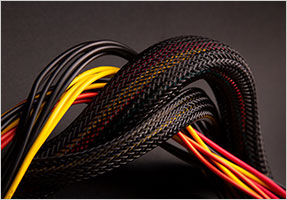
Cable Sleeving Beyond Just Cable Management
Written By: Kassie Teagarden, Senior Content Marketing Specialist, LAPP Tannehill
Cable sleeving is more than just cable management. While its primary purpose is to organize and protect cables, it also meets functional and aesthetic needs.
What is Cable Sleeving?
Cable sleeving is the process of covering your cables with a protective and often decorative material. It involves enclosing the existing cables within a sleeve, which can be made from various materials such as nylon, paracord, or PET. Cable sleeving serves several purposes:
Organization: It helps to keep your cables tidy and prevents them from getting tangled, making it easier to identify and access specific cables. This is particularly beneficial in-home offices, entertainment centers, and server rooms where multiple cables are involved.
Protection: Cable sleeving provides an extra layer of protection against wear and tear, reducing the risk of fraying or damage to the cables. In industrial settings or outdoor applications, where cables are exposed to harsh conditions, such as extreme temperatures, moisture, or abrasion, cable sleeving can shield the cables from damage and extend their lifespan.
Aesthetics: Cable sleeving is an excellent way to customize your electronics and make them stand out. This looks visually appealing and can also act as an extension of one's personal brand or identity.
Heat Dissipation: Cable sleeving can also contribute to heat dissipation in electronic devices. These sleeves can help maintain optimal airflow by grouping and directing cables away from critical components, reducing the risk of overheating and improving the overall performance and longevity of the system.
Cable Identification: In data centers and server rooms, it's essential to have a well-organized cable infrastructure for maintenance and troubleshooting. Cable sleeves can be color-coded or labeled to facilitate easy identification of cables, making it more efficient to manage and maintain the network.
Noise Reduction: Cable sleeving can contribute to noise reduction by reducing cable vibrations and rattling. In audio and recording setups, sleeving can make a significant difference in achieving a cleaner and more professional sound quality.
Cable Concealment: Cable sleeves can be used to conceal cables in the home, offices, or common spaces. By selecting a sleeve that blends with the surroundings, you can hide unsightly cables and maintain a clean and clutter-free environment.
Materials for Cable Sleeving
When it comes to cable sleeving, the choice of material is crucial. There are three common materials for cable sleeving:
Nylon: Nylon sleeving is a popular choice due to its durability and flexibility. It's available in a wide range of colors and patterns, making it suitable for customization.
Paracord: Paracord is a lightweight, durable material originally used in parachute suspension lines. It is an excellent choice for cable sleeving, providing a unique texture and style.
PET (Polyethylene Terephthalate): PET sleeving is known for its heat resistance and durability. It's commonly used in industrial and professional setups.
Tools and Supplies
Before you start cable sleeving, gather the necessary tools and supplies:
- Cable Sleeving Material: Choose the material that best suits your needs.
- Cable Combs: These help maintain the alignment and spacing of the cables within the sleeve.
- Heat Shrink Tubing: To secure the ends of the sleeving and prevent fraying.
- Scissors or Cable Cutters: For trimming the sleeve and cables.
- Lighter or Heat Gun: To heat-shrink the tubing and secure the ends.
- Cable Ties: To help manage the cables during the sleeving process.
LAPP Tannehill offers wire and cable management solutions such cable ties, markers, crimping tools, and stripping tools.
FAQs when selecting cable sleeving
How much cable sleeving should I buy?
Generally, you’ll want to multiply the number of wires by the length of wires and add 10-20% more sleeving in case something needs to be redone in the installation process.
What color scheme should I use for my cable sleeving?
The color scheme you should choose is entirely up to you – you can choose company colors, match the room aesthetics, or to your own personal preference.
How much heat shrink should I use for my cable sleeving project?
Most heat shrink tubing comes in a 2:1 shrink ratio but can also come in a 3:1, 4:1, and 6:1. Read more about determining how much heat shrink tubing you’ll need.
The Cable Sleeving Process
The process of cable sleeving involves several steps:
Preparation: Gather your tools and lay out your cables. Ensure that you have enough sleeving material for your project.
Cutting the Sleeve: Measure the length of the cable and cut the sleeve accordingly, leaving a little extra for adjustments.
Insertion: Slide the sleeve over the cable. If you're having difficulty, you can use a cable threading tool to assist.
Securing the Ends: Use heat shrink tubing to secure the ends of the sleeve. Apply heat with a lighter or heat gun, ensuring a snug fit.
Cable Combs: Use cable combs to maintain cable alignment and spacing. This step is essential for a neat and organized appearance.
Final Adjustments: Trim any excess sleeve material and ensure that the cables are properly managed and organized.
Cable Sleeving Applications
Cable sleeving is purchased by a diverse range of individuals and organizations across various industries. Here are some common applications per purchasers of cable sleeving:
DIY Enthusiasts and Gamers: Many DIY enthusiasts and gamers purchase cable sleeving to customize and organize cables in their computer setups and gaming rigs. They often choose colorful and patterned sleeves to match their aesthetic preferences.
PC Builders and Modders: Individuals who build or modify their own PCs often use cable sleeving to improve cable management, enhance airflow, and create a unique and visually appealing computer system.
Home Theater and Audio Enthusiasts: Those who have home theater systems or high-end audio setups use cable sleeving to conceal and organize the cables connected to their speakers, amplifiers, and other audio equipment.
IT Professionals: IT professionals in corporate settings, data centers, and server rooms purchase cable sleeving to maintain a well-organized and easily identifiable cable infrastructure. It helps with cable management and troubleshooting.
Automotive Enthusiasts: Car and motorcycle enthusiasts use cable sleeving to protect and organize cables in their vehicles, especially when undertaking restoration or customization projects.
Industrial and Manufacturing Companies: Industrial settings often require cable sleeving to protect and organize cables used in machinery and equipment. Cable sleeving can provide insulation and protection against harsh conditions.
Aerospace and Military: Cable sleeving is used in aerospace and military applications to protect cables from extreme temperatures, vibration, and electromagnetic interference.
Marine and Boating Industry: Cable sleeving is essential in marine applications to safeguard cables from saltwater exposure and other marine conditions.
Electricians and Electrical Contractors: Electricians and electrical contractors use cable sleeving for various wiring and cabling projects to ensure the safety and organization of electrical systems.
HVAC and Plumbing Professionals: In heating, ventilation, air conditioning (HVAC), and plumbing installations, cable sleeving may be used to protect and insulate cables and hoses.
Tech Accessory Manufacturers: Companies that produce and sell tech accessories, such as cable management kits or cable sleeves, purchase materials for resale to consumers.
Restoration Specialists: Specialists in vintage electronics restoration and antique restoration often use cable sleeving to maintain the authenticity and functionality of older devices.
Cable Sleeving Distribution Partner in LAPP Tannehill
LAPP Tannehill carries a wide variety of cable sleeving, from general purpose sleeving to sleeving used in applications for harsh environments, available in fiberglass, polyester, expandable, and high temperature.
If you need cable protection from rodents, check out our article on Protecting Your Investments with Rodent-Resistant Cable Sleeving.
Contact us for more information on our cable sleeving solutions and how we can help you with your use case.

